What We Can do to Protect my Food from Animals While Camping?

Camping is an exhilarating experience, offering an escape from the hustle and bustle of daily life into the serene embrace of nature. However, as much as we cherish the wilderness, it comes with its own set of challenges, particularly when it comes to safeguarding our food from the prying eyes and noses of animals.
Whether you’re a seasoned outdoor enthusiast or a novice camper, understanding how to protect your food from animals is essential for a safe and enjoyable camping trip.In this comprehensive guide, we’ll explore various strategies and techniques to keep your food secure from curious critters while camping.
From understanding animal behavior to implementing effective storage methods, we’ll cover everything you need to know to minimize the risk of wildlife encounters and ensure a stress-free camping experience.
Understanding Animal Behavior
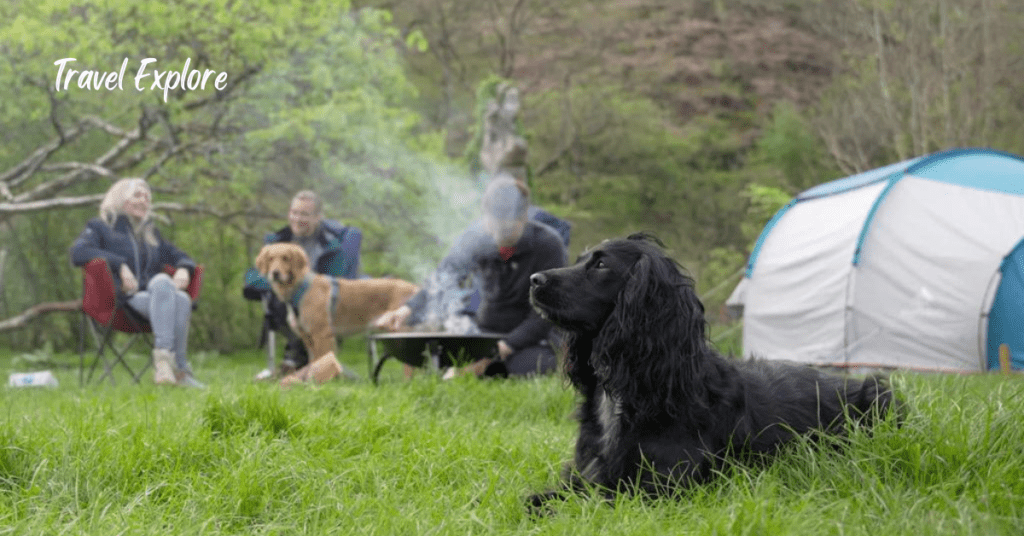
Before we delve into specific methods of protecting food while camping, it’s crucial to understand the behavior of the wildlife you may encounter. Different animals have varying levels of curiosity and persistence when it comes to seeking out human food. By familiarizing yourself with their habits, you can better anticipate their actions and implement appropriate preventive measures.
Types of Animals
Wildlife commonly encountered while camping include bears, raccoons, squirrels, mice, and birds. Each species has its own feeding patterns and preferences, which influence their likelihood of approaching campsites in search of food.
When camping, protecting your food from animals is crucial to ensure your safety and minimize negative interactions with wildlife. There are several strategies you can employ to achieve this. Firstly, invest in proper food storage containers that are designed to be airtight and animal-proof.
These containers should be made of sturdy materials such as hard plastic or metal to withstand potential attempts by animals to access your food. Additionally, consider using bear-resistant food canisters or bags, which are specifically designed to prevent bears and other large animals from accessing your food.
Another effective method is to hang your food in a bear bag or bear hang. This involves suspending your food items from a tree branch using a strong rope or cord, ensuring that it is at least 10 feet above the ground and 4 feet away from the trunk of the tree.
This method makes it difficult for animals to reach your food and is particularly effective against ground-dwelling animals like rodents. Furthermore, be diligent about cleaning up any food scraps or crumbs around your campsite, as these can attract animals even if your main food stash is secured.
Dispose of food waste properly by either burning it in a campfire (where permitted), packing it out in sealed bags, or using designated trash containers. Lastly, it’s essential to educate yourself and your camping companions about proper wildlife etiquette.
Avoid feeding wild animals, as this can habituate them to human food and lead to aggressive behavior. Keep a respectful distance from wildlife and never approach or attempt to pet them, no matter how cute or harmless they may seem.
Food Attractants
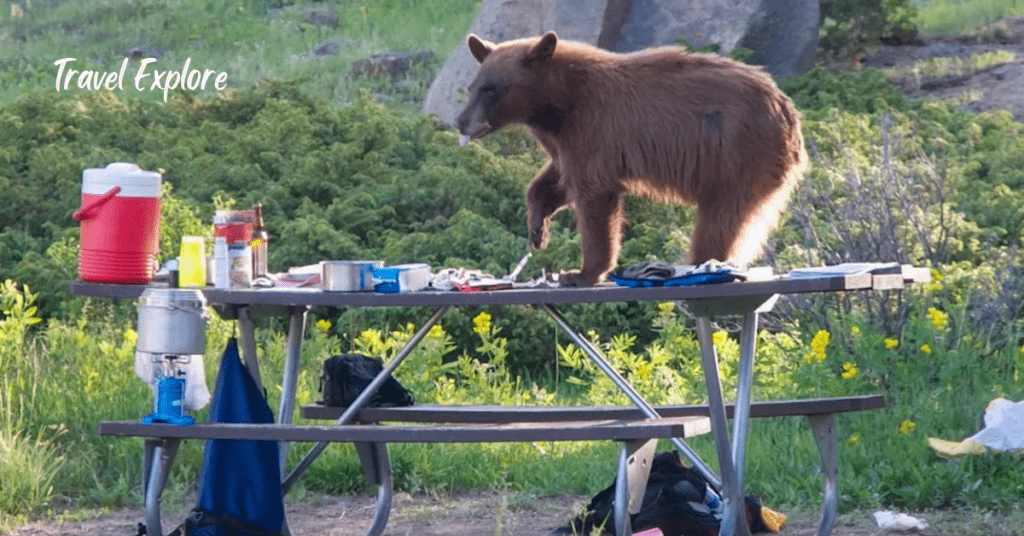
Animals are attracted to campsites primarily by the scent of food. Even small traces of leftovers or improperly stored food can lure them in. It’s essential to minimize food odors and eliminate attractants to reduce the risk of wildlife encounters.
When camping, keeping your food safe from animals is crucial for both your own safety and for the well-being of local wildlife. One effective method is to utilize food attractants, which are substances that either repel or distract animals from your food stash.
Firstly, consider using scent deterrents such as ammonia or vinegar-soaked cloths placed around your food storage area. Animals like bears have a keen sense of smell, and these strong odors can discourage them from approaching.
Additionally, storing your food in airtight containers or bear-resistant canisters adds an extra layer of protection. This prevents animals from detecting the scent of your food and reduces the likelihood of them being attracted to your campsite.
Another strategy is to hang your food high up in a tree, away from your campsite and out of reach of curious critters. Utilizing a bear hang or bear bag system ensures that animals cannot access your food supply.
Effective Food Storage Methods

Now that we have a basic understanding of animal behavior, let’s explore some effective methods for storing food safely during camping trips. Proper food storage not only protects your provisions from animals but also helps maintain their freshness and prevent spoilage.
Bear-Proof Containers

Bear-proof containers are essential camping gear designed to safeguard your food from the curious noses and appetites of wildlife, particularly bears. These containers are constructed with robust materials such as durable plastics or metals, often featuring reinforced lids and locking mechanisms to prevent animals from accessing the contents.
The design typically includes airtight seals to keep scents contained, reducing the likelihood of attracting animals in the first place. Additionally, bear-proof containers are usually designed to be difficult for animals to manipulate or break open, employing mechanisms such as specialized latches or reinforced walls.
When camping in bear country, properly storing food in these containers is not only a matter of convenience but also a crucial safety measure to prevent dangerous encounters between humans and wildlife.
Proper usage of bear-proof containers helps to maintain the natural behavior of wild animals and protects both campers and the animals themselves. In bear country, using bear-proof containers is highly recommended.
These rugged, airtight containers are specifically designed to withstand the strength and persistence of bears, keeping your food secure even in the most remote wilderness areas.
Food Lockers and Bear Canisters
When you’re camping in the wilderness, protecting your food from animals is crucial for both your safety and the preservation of the environment. Food lockers and bear canisters are two primary tools used for this purpose.
Food lockers are typically large metal or plastic containers provided at campsites in bear country. These lockers are designed to securely store all food, cooking utensils, and scented items such as toiletries.
On the other hand, bear canisters are portable, lightweight containers specifically designed to thwart bears’ attempts to access food. Constructed from durable materials like hard plastic or carbon fiber, bear canisters are engineered with locking mechanisms that are virtually impervious to bears’ strength and dexterity.
These canisters are a must-have for backpackers and backcountry campers who venture into areas inhabited by bears, as they provide a reliable means of safeguarding food and scented items while on the move.
Proper usage of bear canisters not only protects your food but also helps maintain the natural behaviors of wildlife by discouraging them from associating humans with easily accessible food sources.
Campsite Selection and Preparation

Selecting the right campsite and properly preparing it can significantly reduce the risk of animal encounters.
Choose a Suitable Location
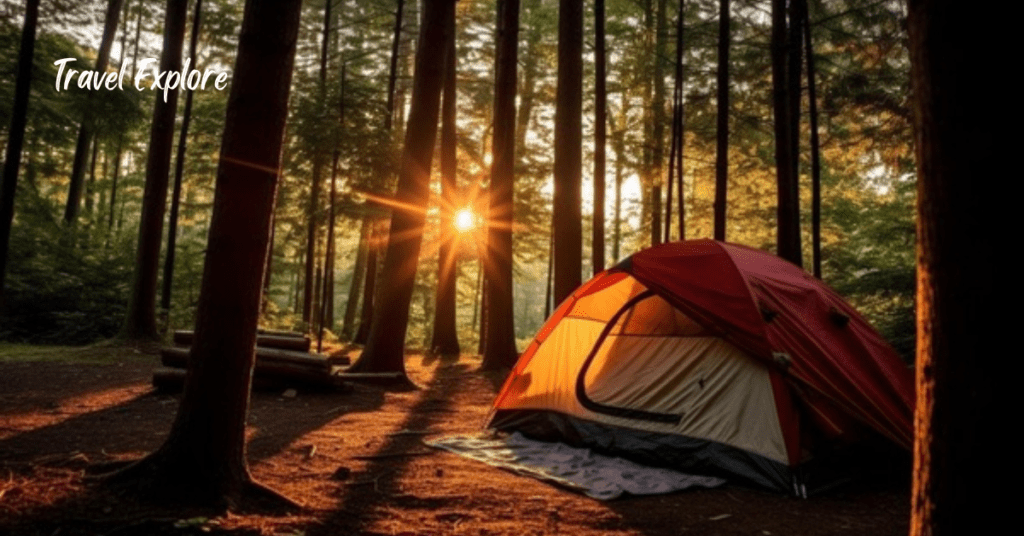
When choosing a campsite, opt for areas that are away from known animal habitats and trails. Avoid setting up camp near water sources or areas with dense vegetation, as these may attract wildlife seeking food and shelter.
One suitable location to create a camping environment that is less attractive to wildlife would be an area with sparse vegetation and open terrain. Such locations typically have less natural cover and food sources for wildlife, making them less enticing for animals to explore.
Avoiding camping near water sources such as rivers or lakes can also help minimize wildlife encounters, as these areas tend to attract a variety of animals for drinking and hunting. Additionally, setting up camp away from known animal migration routes or nesting areas can further reduce the likelihood of wildlife disturbances.
When selecting a camping spot, it’s important to consider factors such as prevailing winds and potential noise levels, as these can also influence wildlife behavior. Finally, practicing proper food storage and waste disposal techniques.
Use Natural Barriers
Utilize natural barriers such as rivers, cliffs, or dense vegetation to create boundaries around your campsite. These barriers can deter animals from approaching and accessing your food supplies.
Creating a camping environment that is less attractive to wildlife involves understanding the habits and needs of local animals and implementing measures to deter them from encroaching on the campsite.
One effective strategy is to utilize natural barriers that act as deterrents or obstacles to wildlife. These barriers can include dense vegetation, such as shrubs or bushes, strategically placed around the perimeter of the campsite.
Dense foliage creates a visual barrier that can discourage wildlife from entering the area, as they may perceive it as difficult terrain to navigate or as potential hiding spots for predators. Additionally, natural barriers like thorny plants or prickly bushes can physically deter animals from approaching, as they provide an uncomfortable or painful experience upon contact.
Another option is to utilize topographical features such as rocky terrain or steep slopes, which can create natural boundaries that are challenging for wildlife to traverse. By incorporating these natural barriers into the camping environment, campers can reduce the likelihood of encountering wildlife and minimize potential conflicts between humans and animals.
Additionally, maintaining a clean campsite by properly disposing of food waste and securely storing food supplies in animal-proof containers further diminishes the attractiveness of the area to wildlife, ensuring a safer and more enjoyable camping experience for all.
Additional Tips for Wildlife Safety
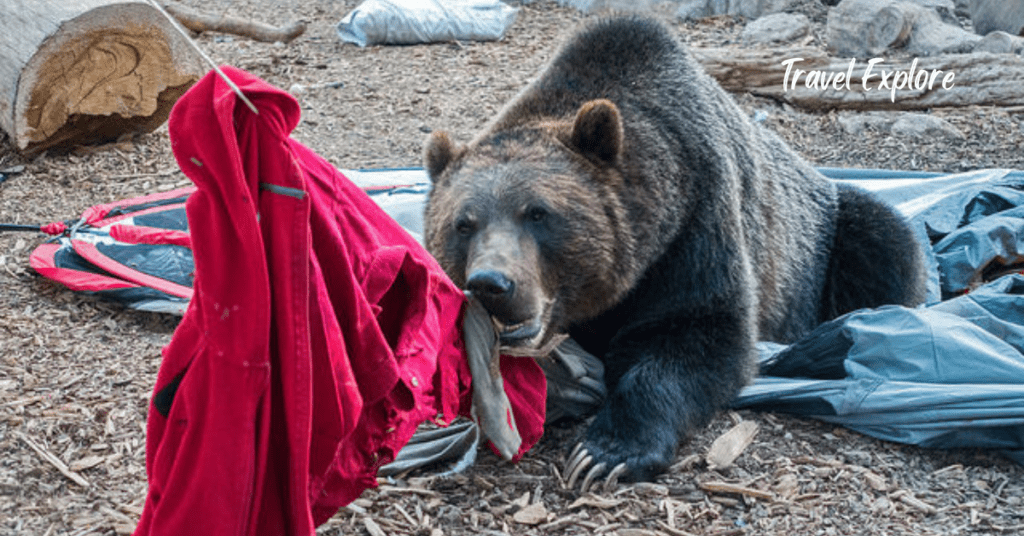
Additional tips for wildlife safety include cooking and eating away from your campsite to minimize food odors, properly disposing of food waste to avoid attracting animals, and being prepared for emergencies by carrying bear spray and knowing how to respond calmly to wildlife encounters.
Cook and Eat Away from Camp
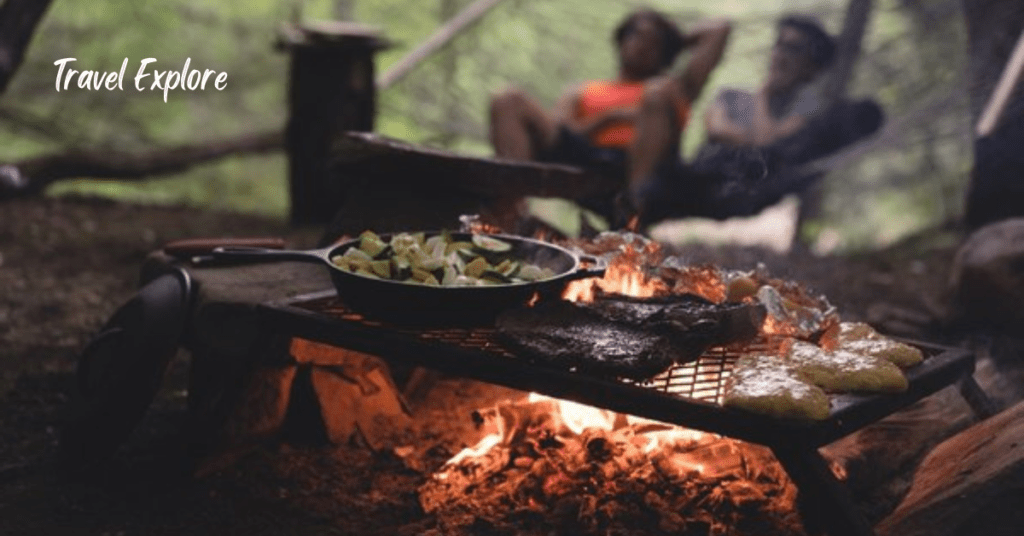
To minimize food odors around your campsite, designate a separate area for cooking and eating meals. Cook food away from your tent and designated sleeping areas to prevent lingering smells that may attract animals.
When cooking and eating away from camp, especially in wilderness areas, it’s crucial to prioritize wildlife safety to ensure both your own safety and the well-being of the animals. Firstly, choose a cooking spot that is at least 200 feet away from your campsite and any areas where you plan to sleep.
Before starting your meal preparations, thoroughly clean any surfaces you’ll be using and keep food stored securely in sealed containers to minimize odors that might attract wildlife. During mealtime, maintain a clean and organized cooking area, promptly disposing of any food scraps or waste in designated trash containers or by packing them out with you.
After cooking, ensure all food remnants and cooking utensils are thoroughly cleaned and stored away to eliminate any lingering scents.
Dispose of Waste Properly
Properly dispose of food waste, including scraps and leftovers, to avoid attracting wildlife. Pack out all garbage and dispose of it in designated trash receptacles or bear-proof bins. When disposing of waste properly to ensure wildlife safety, there are several key considerations to keep in mind.
Firstly, it’s essential to understand that improperly discarded waste can pose significant risks to wildlife by entangling animals, contaminating their habitats, or even being ingested by them, leading to injury or death.
Therefore, one important tip is to always use designated trash receptacles or recycling bins whenever possible. By properly disposing of waste in designated areas, you minimize the chances of wildlife encountering and being harmed by it.
Another crucial aspect of waste disposal for wildlife safety is to properly secure trash bags and bins to prevent them from being knocked over or torn open by animals. This can be achieved by using sturdy containers with tight-fitting lids or by securing trash bags in closed bins.
Conclusion & Recap
Protecting your food from animals while camping requires a proactive approach that encompasses understanding wildlife behavior, implementing proper food storage techniques, selecting suitable campsites, utilizing wildlife deterrents, and practicing environmental stewardship.
hese essential strategies and adhering to Leave No Trace principles, you can minimize the risk of wildlife encounters, preserve the natural beauty of wilderness areas, and ensure a safe and enjoyable camping experience for yourself and future generations.
Such as Understanding the Risks, Utilizing Wildlife Deterrents, Proper Food Storage Techniques By implementing these strategies and principles, you can enjoy the beauty of nature while minimizing your impact on the environment and promoting coexistence with local wildlife.
FAQS
Why is it important to protect food from animals while camping?
Camping in areas with abundant wildlife increases the risk of animals being attracted to human food sources. Failure to properly protect food can lead to dangerous encounters between campers and animals, as well as potential damage to the ecosystem.
What types of animals are commonly attracted to campsite food?
Various animals, including bears, raccoons, squirrels, mice, and birds, are known to be attracted to human food. The presence of these animals can vary depending on the location and habitat of the campsite.
How can improperly stored food impact the environment?
Leaving food unsecured or improperly stored can lead to animals scavenging through trash bins and campsites, resulting in litter and pollution. Additionally, human food can disrupt natural diets and behaviors of wildlife, leading to imbalances in the ecosystem.
Are there legal implications for not properly storing food while camping?
Many camping areas have regulations in place regarding food storage to minimize human-wildlife conflicts. Failure to comply with these regulations can result in fines or other penalties. It’s essential for campers to familiarize themselves with the rules of their chosen camping destination.
What are the consequences of a wildlife encounter due to improperly stored food?
Wildlife encounters resulting from improperly stored food can have serious consequences for both humans and animals. In extreme cases, such encounters can lead to injuries or fatalities for campers, as well as euthanasia or relocation of habituated animals by wildlife authorities.




